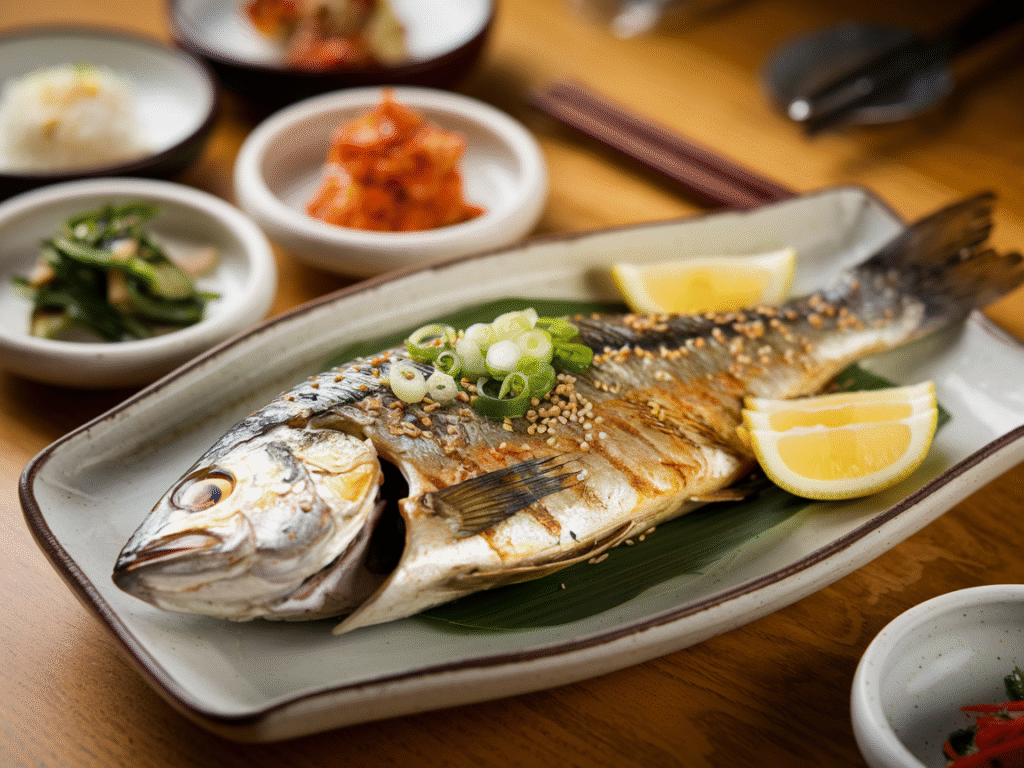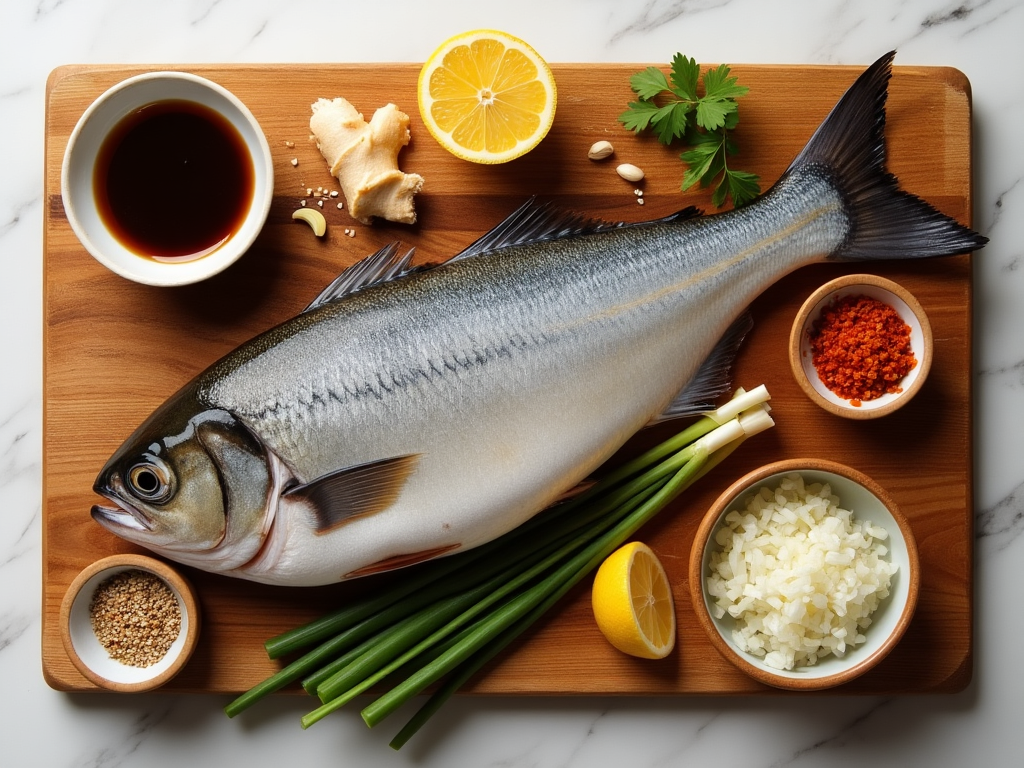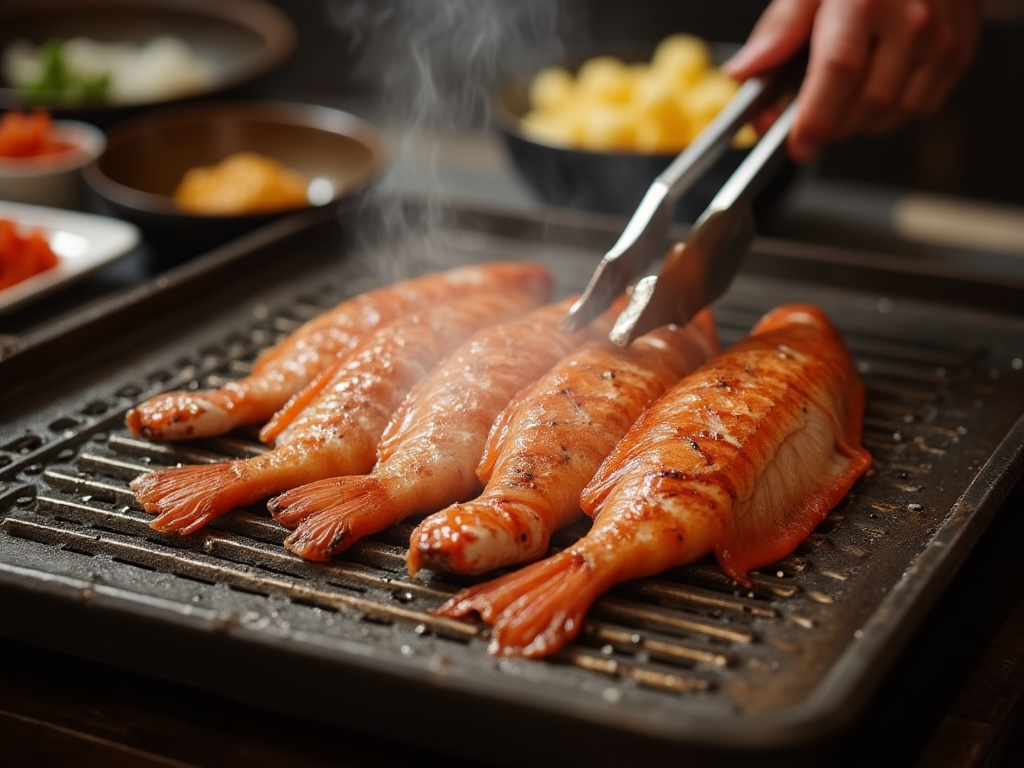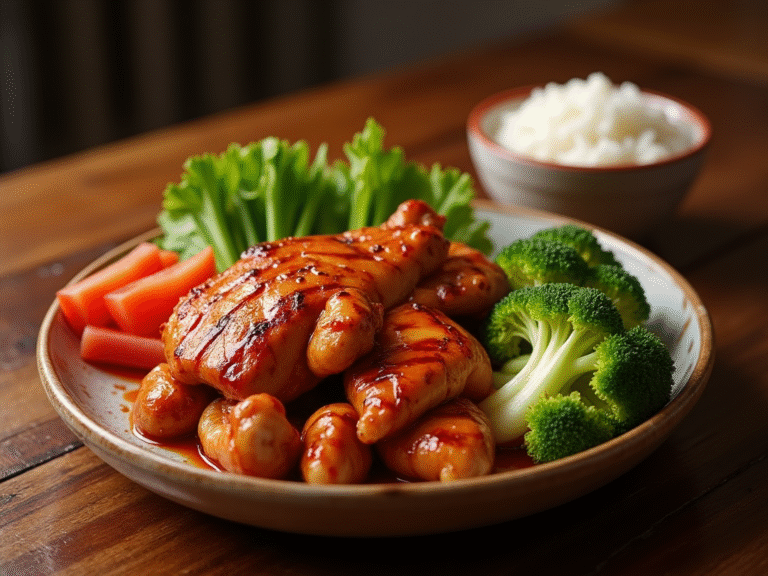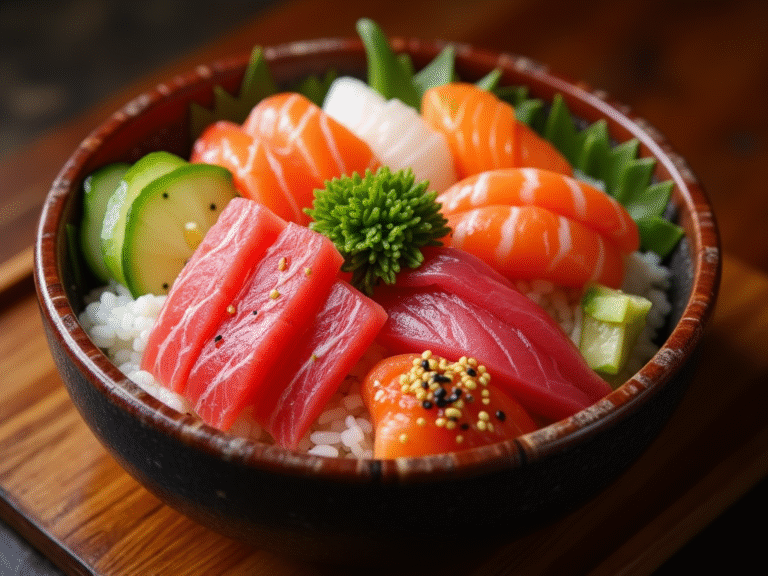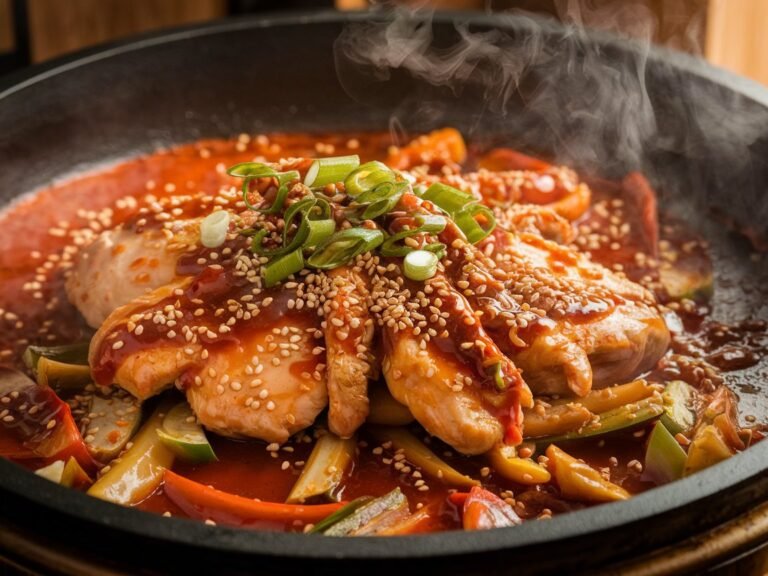Authentic Korean Grilled Fish (Saengseon Gui) – Easy 30-Minute Recipe
The Ultimate Korean Grilled Fish (Saengseon Gui): Your Gateway to Authentic Korean Comfort Food
Introduction
Picture this: a perfectly grilled fish with crispy, golden-brown skin that crackles when you break into it, revealing tender, flaky meat infused with the deep umami flavors of soy sauce, the nuttiness of sesame oil, and the gentle warmth of fresh ginger. This is Saengseon Gui, the Korean grilled fish that transforms a simple piece of seafood into something absolutely extraordinary.
If you’ve ever walked past a Korean restaurant and caught that irresistible aroma of grilling fish mixed with garlic and sesame, you know exactly what magic we’re about to create in your kitchen. The best part? This seemingly restaurant-quality dish is surprisingly simple to master at home, requiring just a handful of pantry staples and about 30 minutes of your time.
Why You’ll Love This Recipe
What makes Saengseon Gui so special isn’t just its incredible taste—it’s the perfect balance of simplicity and sophistication. Unlike heavy, battered fish dishes, this Korean classic lets the natural flavors of fresh fish shine through while adding just enough seasoning to make every bite memorable. The marinade does double duty here, both flavoring the fish and helping create that coveted crispy exterior that Korean cuisine is famous for.
You’re going to fall head over heels for this recipe because it checks every box: it’s healthy without being boring, impressive enough for dinner parties yet simple enough for weeknight dinners, and customizable to work with whatever fish you have available. Plus, once you master the basic technique, you’ll have a foundation for exploring countless variations that’ll keep your dinner rotation exciting for months to come.
Ingredients Breakdown
The beauty of Saengseon Gui lies in its straightforward ingredient list. Each component plays a crucial role in building those complex, layered flavors that make Korean cuisine so addictive. Let me walk you through everything you’ll need and why each ingredient matters.
The Fish (2 pounds, about 4 servings) Your choice of fish is the star here, so quality matters. Mackerel is the traditional choice in Korea, prized for its rich, oily flesh that stays moist during grilling. However, sea bass, red snapper, or even salmon work beautifully. Look for fish with firm flesh and bright, clear eyes if buying whole. The skin should be shiny and scales intact. If you’re using fillets, aim for pieces about 1-inch thick to prevent overcooking.
Soy Sauce (4 tablespoons) This forms the salty, umami backbone of your marinade. Korean soy sauce (ganjang) is ideal if you can find it, as it’s slightly less salty than Japanese varieties. Regular soy sauce works perfectly fine, though you might want to reduce the amount slightly if you’re sensitive to salt. For a gluten-free option, tamari is your best friend here.
Sesame Oil (2 tablespoons) The nutty, toasted flavor of sesame oil is absolutely non-negotiable in this recipe. It’s what gives Saengseon Gui that distinctly Korean character. Always use toasted sesame oil rather than plain—the difference is night and day. Store your bottle in the refrigerator after opening to preserve its delicate flavor.
Fresh Garlic (4 cloves, minced) Fresh garlic brings pungency and depth that powdered simply can’t match. Mince it finely to ensure even distribution in your marinade. Pro tip: make a paste with a pinch of salt using the flat side of your knife for even better integration into the marinade.
Fresh Ginger (1 tablespoon, grated) Ginger adds a bright, slightly spicy note that cuts through the richness of the fish. Always use fresh—the jarred stuff won’t give you the same vibrant flavor. Freeze your ginger root and grate it directly into the marinade for the easiest prep.
Korean Red Pepper Flakes – Gochugaru (1 tablespoon, optional) While not always traditional, a touch of gochugaru adds gentle heat and a beautiful red color. It’s much milder than regular red pepper flakes with a slightly sweet, smoky flavor. Start with less if you’re heat-sensitive.
Rice Wine or Mirin (2 tablespoons) This adds subtle sweetness and helps the fish caramelize beautifully. Mirin is slightly sweeter than rice wine, so adjust accordingly. In a pinch, a tablespoon of sugar dissolved in a tablespoon of water works.
Green Onions (3 stalks) These serve double duty—one stalk goes into the marinade for flavor, while the others become a fresh, crispy garnish. The white parts are more pungent, while the green tops add color and mild onion flavor.
Sesame Seeds (2 tablespoons) Toasted sesame seeds aren’t just garnish—they add textural interest and amplify the nutty notes from the sesame oil. Toast them yourself in a dry pan for maximum flavor, watching carefully as they go from perfect to burnt in seconds.
Step-by-Step Instructions
Now comes the exciting part—transforming these simple ingredients into a dish that’ll have everyone asking for your secret. Follow these steps carefully, and you’ll nail it on your first try.
Step 1: Prepare Your Fish (10 minutes) Start by patting your fish completely dry with paper towels. This is crucial—any excess moisture will prevent that beautiful crispy skin from forming. If using whole fish, make three diagonal cuts on each side, going about halfway through the flesh. These cuts serve multiple purposes: they help the marinade penetrate deeper, ensure even cooking, and create more surface area for that delicious char. For fillets, skip the cuts but do score the skin side lightly to prevent curling during cooking.
Step 2: Create the Marinade (5 minutes) In a bowl large enough to eventually hold your fish, whisk together the soy sauce, sesame oil, minced garlic, grated ginger, rice wine, and finely chopped white parts of one green onion. If you’re using gochugaru, add it now. The marinade should be thick enough to coat the back of a spoon but still pourable. Give it a taste—it should be boldly flavored since much of it will cook off. The balance should lean slightly salty and savory with background notes of nuttiness and warmth.
Step 3: Marinate the Fish (15-30 minutes) Place your fish in the marinade, turning to coat all sides thoroughly. If using whole fish, make sure to get marinade into those cuts you made. For the best flavor penetration, let it sit for 30 minutes at room temperature, turning once halfway through. If you’re short on time, even 15 minutes will make a difference. Don’t marinate for more than an hour, though, as the acid in the marinade can start to break down the fish’s texture, making it mushy.
Step 4: Prepare Your Grilling Station (5 minutes) While the fish marinates, get your grill or grill pan ready. If using an outdoor grill, clean the grates thoroughly and oil them well—fish is notorious for sticking. Heat to medium-high, around 400-425°F. For indoor cooking, a cast-iron grill pan or even a regular cast-iron skillet works beautifully. Heat it over medium-high heat until a drop of water immediately sizzles and evaporates. Have your fish spatula or turner ready—the thin, flexible kind works best for fish.
Step 5: Grill the Fish (8-12 minutes) Remove the fish from the marinade, letting excess drip off but don’t wipe it clean—that coating is flavor! Place the fish on your hot grill, presentation side down first. This is usually the side without skin for fillets, or the side you want facing up when plated. Don’t move it for at least 4-5 minutes. You’ll know it’s ready to flip when it releases easily from the grill and has developed nice char marks. Flip carefully and cook for another 4-6 minutes. The fish is done when it flakes easily and reaches an internal temperature of 145°F.
Step 6: The Finishing Touches (2 minutes) Transfer your perfectly grilled fish to a serving platter. While it’s still hot, brush with a little extra sesame oil for shine and extra flavor. Sprinkle generously with toasted sesame seeds and the sliced green parts of your scallions. If you’re feeling fancy, add a squeeze of fresh lemon juice right before serving—the acidity brightens all the flavors beautifully.
Step 7: Rest and Serve (3 minutes) Let the fish rest for just 2-3 minutes before serving. This allows the juices to redistribute, ensuring every bite is moist and flavorful. Serve immediately while the exterior is still crispy and the inside is perfectly tender.
Tips and Variations
Mastering Saengseon Gui is all about understanding the techniques and then making it your own. Here are my hard-won tips for consistent success, plus exciting variations to keep things interesting.
Expert Tips for Perfect Results:
The single most important factor for success is starting with room temperature fish. Cold fish straight from the fridge will cook unevenly, leaving you with a burnt exterior and raw center. Take your fish out 20-30 minutes before cooking.
Don’t overcrowd your grill or pan. Fish needs space to properly sear and develop that crispy exterior. If cooking for a crowd, work in batches rather than cramming everything together.
Invest in a good fish spatula. That thin, flexible blade makes flipping delicate fish so much easier and reduces the chance of your beautiful fillet falling apart.
For extra crispy skin, lightly dust the skin side with cornstarch before marinating. This absorbs excess moisture and helps achieve that restaurant-quality crispiness.
Delicious Variations to Try:
Spicy Gochujang Version: Mix 2 tablespoons of gochujang (Korean chili paste) into your marinade for a spicier, more complex flavor profile. The fermented chili paste adds depth and a beautiful red color that’s absolutely gorgeous on the plate.
Citrus-Miso Twist: Replace half the soy sauce with white miso paste and add the zest of one orange. This Japanese-Korean fusion creates an incredibly sophisticated flavor that’s perfect for dinner parties.
Honey-Garlic Glazed: Add 2 tablespoons of honey to the marinade and double the garlic. During the last minute of grilling, brush with extra honey-garlic mixture for a glossy, caramelized finish.
Vegetarian Alternative: This marinade works wonderfully with firm tofu or thick slices of king oyster mushrooms. Press the tofu well and marinate for at least an hour for best results.
Serving Suggestions
Saengseon Gui is incredibly versatile when it comes to serving options. In Korea, it’s typically part of a larger spread with various banchan (side dishes), but it’s equally wonderful as a standalone main course.
Traditional Korean Spread: Serve your grilled fish with steamed white rice, kimchi, seasoned spinach (sigeumchi namul), and Korean potato salad. Add ssamjang (Korean dipping sauce) and fresh lettuce leaves for wrapping. This creates an interactive dining experience where everyone can customize their bites.
Modern Fusion Presentations: Flake the grilled fish over a bed of mixed greens with sliced avocado, cucumber, and a sesame-ginger dressing for an incredible salad. Or serve it over cauliflower rice with sautéed bok choy for a low-carb option that doesn’t sacrifice flavor.
Perfect Pairings: Cold beer is the classic accompaniment—Korean lagers like Hite or Cass are traditional, but any crisp pilsner works beautifully. For wine lovers, a dry Riesling or Albariño complements the fish without overwhelming the delicate flavors. Makgeolli (Korean rice wine) offers an authentic experience if you can find it.
Garnish Ideas: Beyond the classic sesame seeds and scallions, consider adding microgreens for elegance, thin lemon wheels for color, or a sprinkle of furikake for extra umami. A small dish of ponzu sauce on the side lets guests add extra citrusy brightness if desired.
Storage and Reheating Instructions
While Saengseon Gui is definitely best enjoyed fresh off the grill, proper storage and reheating techniques can help you enjoy leftovers that are almost as good as the original.
Refrigerator Storage: Cool the fish completely before storing—about 30 minutes at room temperature. Place in an airtight container, separating layers with parchment paper to prevent sticking. Properly stored, it’ll keep for up to 3 days in the refrigerator. The flavors actually deepen overnight, making cold leftover Saengseon Gui fantastic in salads or grain bowls.
Freezer Storage: For longer storage, wrap individual portions tightly in plastic wrap, then place in freezer bags, removing as much air as possible. Label with the date and contents. Frozen grilled fish maintains best quality for up to 2 months, though it’s safe indefinitely if kept at 0°F.
Reheating Methods: The oven is your best bet for maintaining texture. Preheat to 275°F, place fish on a baking sheet, and cover loosely with foil. Heat for 10-15 minutes until warmed through. A few drops of water under the foil creates steam that prevents drying.
For quicker reheating, the microwave works but requires care. Place fish on a microwave-safe plate, cover with a damp paper towel, and heat at 50% power in 30-second intervals. This gentle approach prevents that rubbery texture microwaved fish often develops.
The air fryer offers a fantastic middle ground—350°F for 3-4 minutes returns much of the original crispiness while heating evenly.
Recipe Notes
These little details make the difference between good and extraordinary Saengseon Gui:
This recipe scales beautifully for crowds. Simply multiply the marinade ingredients proportionally, but keep the marinating time the same.
For meal prep enthusiasts, you can marinate the fish the night before. The longer marination intensifies flavors, though the texture might be slightly softer.
Always use a 6-quart or larger grill pan if cooking indoors to prevent overcrowding and ensure proper heat circulation.
Freshly shredded ginger releases more juice and flavor than pre-grated options. Keep ginger in the freezer and grate directly into your marinade—it’s easier to grate frozen and stays fresh for months.
The marinade also works wonderfully as a sauce. Simply bring leftover marinade to a boil for food safety, then simmer until slightly thickened. Drizzle over the finished fish for extra flavor.
For the most authentic flavor, seek out Korean sesame oil (chamgireum) from an Asian market. It’s toasted darker than Japanese varieties, providing a more intense nutty flavor.
Nutrition Information (Per Serving)
| Nutrient | Amount |
|---|---|
| Calories | 285 |
| Total Fat | 12g |
| Saturated Fat | 2.5g |
| Carbohydrates | 8g |
| Sugar | 3g |
| Fiber | 1g |
| Protein | 35g |
| Sodium | 680mg |
| Cholesterol | 75mg |
| Calcium | 45mg |
| Iron | 2.8mg |
Nutrition information is an estimate and may vary based on specific ingredients used.
Recipe Card Summary
Course: Main Dish
Cuisine: Korean
Servings: 4
Prep Time: 20 minutes
Cook Time: 12 minutes
Total Time: 32 minutes (plus marinating time)
Ingredients:
- 2 pounds fish (mackerel, sea bass, or snapper)
- 4 tablespoons soy sauce
- 2 tablespoons sesame oil
- 4 cloves garlic, minced
- 1 tablespoon fresh ginger, grated
- 1 tablespoon gochugaru (optional)
- 2 tablespoons rice wine or mirin
- 3 green onions, divided
- 2 tablespoons sesame seeds, toasted
- Lemon wedges for serving
Instructions:
- Pat fish dry and make diagonal cuts if using whole fish
- Mix soy sauce, sesame oil, garlic, ginger, rice wine, and chopped white parts of green onion
- Marinate fish for 15-30 minutes, turning once
- Preheat grill or grill pan to medium-high heat
- Grill fish 4-5 minutes per side until charred and cooked through
- Brush with sesame oil and garnish with sesame seeds and sliced green onions
- Rest 2-3 minutes before serving
Notes:
- Room temperature fish cooks more evenly
- Don’t move fish during initial searing for best crust
- Can be marinated overnight for deeper flavor
Diet Tags: Dairy-Free, Gluten-Free (with tamari), High-Protein, Low-Carb, Paleo-Friendly, Whole30 (with coconut aminos)
Health Benefits Section
Saengseon Gui isn’t just delicious—it’s a nutritional powerhouse that fits beautifully into a healthy lifestyle. The star ingredient, fish, provides high-quality lean protein essential for muscle maintenance and repair. Fatty fish like mackerel delivers omega-3 fatty acids, particularly EPA and DHA, which support heart health, reduce inflammation, and boost brain function.
Garlic and ginger, beyond their flavor contributions, offer impressive health benefits. Garlic contains allicin, a compound with antimicrobial and heart-protective properties. Fresh ginger aids digestion, reduces nausea, and has anti-inflammatory effects that may help with joint pain and muscle soreness.
Sesame seeds and oil provide healthy fats, calcium, and magnesium. They’re also rich in lignans, plant compounds that may help balance hormones and reduce cholesterol. The minimal use of oil in grilling makes this cooking method one of the healthiest, preserving nutrients while keeping calories in check.
Sauce Recommendations
While Saengseon Gui is perfectly delicious on its own, these Korean-inspired sauces elevate it to restaurant-quality status:
Ssamjang (Korean Dipping Sauce): Mix 2 tablespoons doenjang (soybean paste), 1 tablespoon gochujang, 1 teaspoon sesame oil, 1 minced garlic clove, and 1 teaspoon honey. This creates a complex, umami-rich sauce that complements the fish beautifully.
Cho-Gochujang (Sweet and Spicy Sauce): Combine 2 tablespoons gochujang with 1 tablespoon rice vinegar, 1 tablespoon sugar, and 1 teaspoon sesame oil. This bright, tangy sauce cuts through the richness of grilled fish perfectly.
Simple Soy-Scallion Sauce: Mix 3 tablespoons soy sauce, 1 tablespoon rice vinegar, 1 teaspoon sugar, and 2 finely sliced scallions. Add a pinch of red pepper flakes for heat. This light sauce won’t overpower delicate fish flavors.
Avoid These Mistakes During the Process
The biggest mistake people make is moving the fish too soon. Patience is crucial—if the fish resists when you try to flip it, it needs more time. Forcing it will tear the flesh and ruin your presentation.
Never skip drying the fish thoroughly. Excess moisture is the enemy of crispy skin and proper searing. This single step makes the difference between restaurant-quality and mediocre results.
Avoid using cold fish straight from the refrigerator. The temperature shock causes uneven cooking, leaving you with an overcooked exterior and undercooked center.
Don’t overmarinate. While it seems like longer would mean more flavor, the acid in the marinade actually begins cooking the fish, resulting in a mushy texture that’s far from appetizing.
Resist the temptation to use high heat throughout. While you want a hot grill for searing, excessive heat chars the outside before the inside cooks through.
Frequently Asked Questions
Can I use frozen fish for this recipe? Absolutely! Thaw your fish completely in the refrigerator overnight, then pat extra dry since frozen fish tends to release more moisture. The results will be nearly identical to fresh fish when properly handled.
What if I don’t have a grill or grill pan? A regular skillet works perfectly. You won’t get grill marks, but the flavor will be just as delicious. Consider finishing under the broiler for a minute to get some char on top.
Is there a substitute for sesame oil? While sesame oil is quite unique, you can use neutral oil with a dash of toasted sesame seeds ground into a paste. However, sesame oil is worth seeking out as it’s essential to authentic Korean flavor.
How do I know when the fish is perfectly cooked? The fish should flake easily when tested with a fork and appear opaque throughout. An instant-read thermometer should register 145°F at the thickest part. The texture should be moist and tender, not dry or rubbery.
Can I make this recipe ahead for a dinner party? You can marinate the fish up to 24 hours ahead and prep all garnishes in advance. However, grilling should be done just before serving for the best texture and presentation.
What’s the best fish for beginners to try? Salmon is the most forgiving due to its fat content, which prevents it from drying out easily. It’s also readily available and doesn’t have a strong fishy taste that might overwhelm those new to Korean cuisine.
Final Thoughts
There’s something deeply satisfying about mastering Saengseon Gui. Maybe it’s the way your kitchen fills with those incredible aromas of garlic, ginger, and sesame. Or perhaps it’s the pride you feel serving a dish that looks like it came from a high-end Korean restaurant but actually took you less than an hour to create.
This recipe represents everything I love about Korean cooking—bold flavors achieved through simple techniques, healthy ingredients transformed into something crave-worthy, and the perfect balance of tradition and adaptability. Whether you’re cooking for a quiet Tuesday night dinner or hosting friends for a Korean feast, Saengseon Gui delivers every single time.
The beauty of this dish extends beyond its taste. It’s a gateway into Korean cuisine that doesn’t require special equipment or hard-to-find ingredients. Once you’ve mastered this basic technique, you’ll find yourself experimenting with different fish, playing with the marinade ratios, and maybe even creating your own signature version.
I encourage you to make this recipe your own. Try different fish based on what’s fresh at your market. Adjust the heat level to suit your family’s preferences. Experiment with the garnishes and sides until you find your perfect combination. That’s the joy of cooking—taking a traditional recipe and adding your personal touch.
Whether you’re feeding a crowd at your next dinner party or simply craving something different from your usual weeknight routine, this Saengseon Gui is guaranteed to become a regular in your recipe rotation. The combination of minimal prep time, maximum flavor, and impressive presentation makes it a winner every time.
So fire up that grill, gather your ingredients, and get ready to transport your taste buds straight to Seoul. Once you experience that first bite of perfectly grilled fish with its crispy exterior giving way to tender, flavorful meat, you’ll understand why Saengseon Gui has been a beloved staple of Korean cuisine for generations.
Let me know how your Saengseon Gui adventure turns out! Drop a comment below with your favorite fish to use or any creative variations you’ve discovered. Happy grilling, and remember—the secret to great Korean cooking isn’t just in the recipe, it’s in cooking with confidence and joy!

